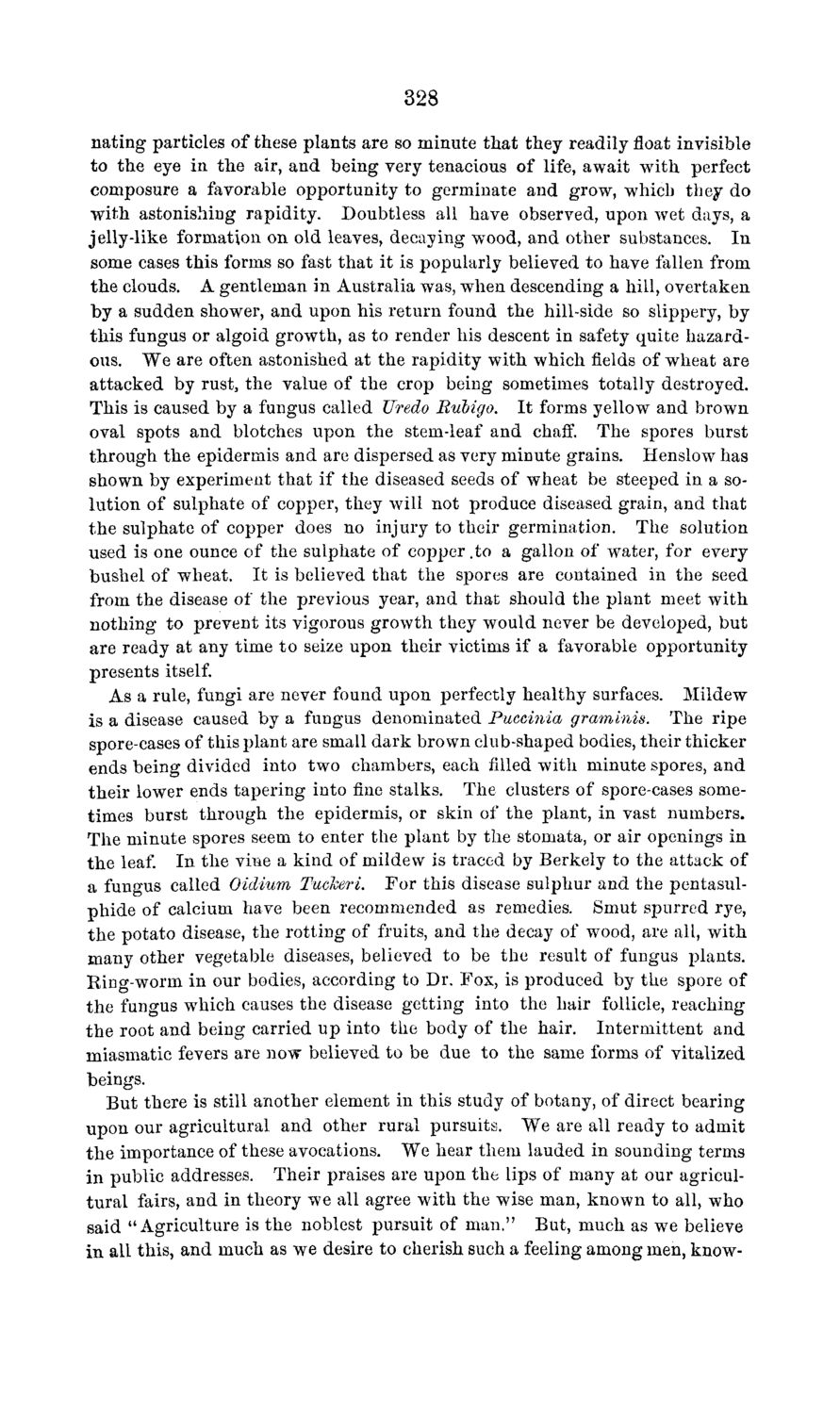| |
| |
Caption: Board of Trustees Minutes - 1869
This is a reduced-resolution page image for fast online browsing.

EXTRACTED TEXT FROM PAGE:
328 nating particles of these plants are so minute that they readily float invisible to the eye in t h e air, and being very tenacious of life, await with perfect composure a favorable opportunity to germinate and grow, which they do with astonishing rapidity. Doubtless all have observed, upon wet days, a jelly-like formation on old leaves, decaying wood, and other substances. I n some cases this forms so fast that it is popularly believed to have fallen from the clouds. A gentleman in Australia was, when descending a hill, overtaken by a sudden shower, and upon his return found the hill-side so slippery, by this fungus or algoid growth, as to render his descent in safety quite hazardous. We are often astonished at the rapidity with which fields of wheat are attacked by rust, the value of the crop being sometimes totally destroyed. This is caused by a fungus called Uredo Bubigo. It forms yellow and brown oval spots and blotches upon the stem-leaf and chaff. The spores burst through the epidermis and are dispersed as very minute grains. Henslow has shown by experiment that if the diseased seeds of wheat be steeped in a solution of sulphate of copper, they will not produce diseased grain, and that t h e sulphate of copper does no injury to their germination. The solution used is one ounce of the sulphate of copper .to a gallon of water, for every bushel of wheat. It is believed that the spores are contained in the seed from the disease of the previous year, and that should the plant meet with nothing to prevent its vigorous growth they would never be develojjed, but are ready at any time t o seize upon their victims if a favorable opportunity presents itself. As a rule, fungi are never found upon perfectly healthy surfaces. Mildew is a disease caused by a fungus denominated Puccinia gram i/lis. The ripe spore-cases of this plant are small dark brown club-shaped bodies, their thicker ends being divided into two chambers, each filled with minute spores, and their lower ends tapering into fine stalks. The clusters of spore-cases sometimes burst through the epidermis, or skin of the plant, in vast numbers. The minute spores seem to enter the plant by the stomata, or air openings in the leaf. In t h e vine a kind of mildew is traced by Berkely to the attack of a fungus called Oiclium Tuckeri. F o r this disease sulphur and the pentasulphide of calcium have been recommended as remedies. Smut spurred rye, the potato disease, the rotting of fruits, and the decay of wood, are all, with many other vegetable diseases, believed to be the result of fungus plants. Ring-worm in our bodies, according to Dr. Fox, is produced by the spore of the fungus which causes the disease getting into the hair follicle, reaching t h e root and being carried u p into the body of the hair. Intermittent and miasmatic fevers are now believed to be due to the same forms of vitalized beings. But there is still another element in this study of botany, of direct bearing upon our agricultural and other rural pursuits. We are all ready to admit t h e importance of these avocations. We hear them lauded in sounding terms in public addresses. Their praises are upon the lips of many at our agricultural fairs, and in theory we all agree with the wise man, known to all, who said " Agriculture is the noblest pursuit of man." But, much as we believe in all this, and much as we desire to cherish such a feeling among men, know-
| |